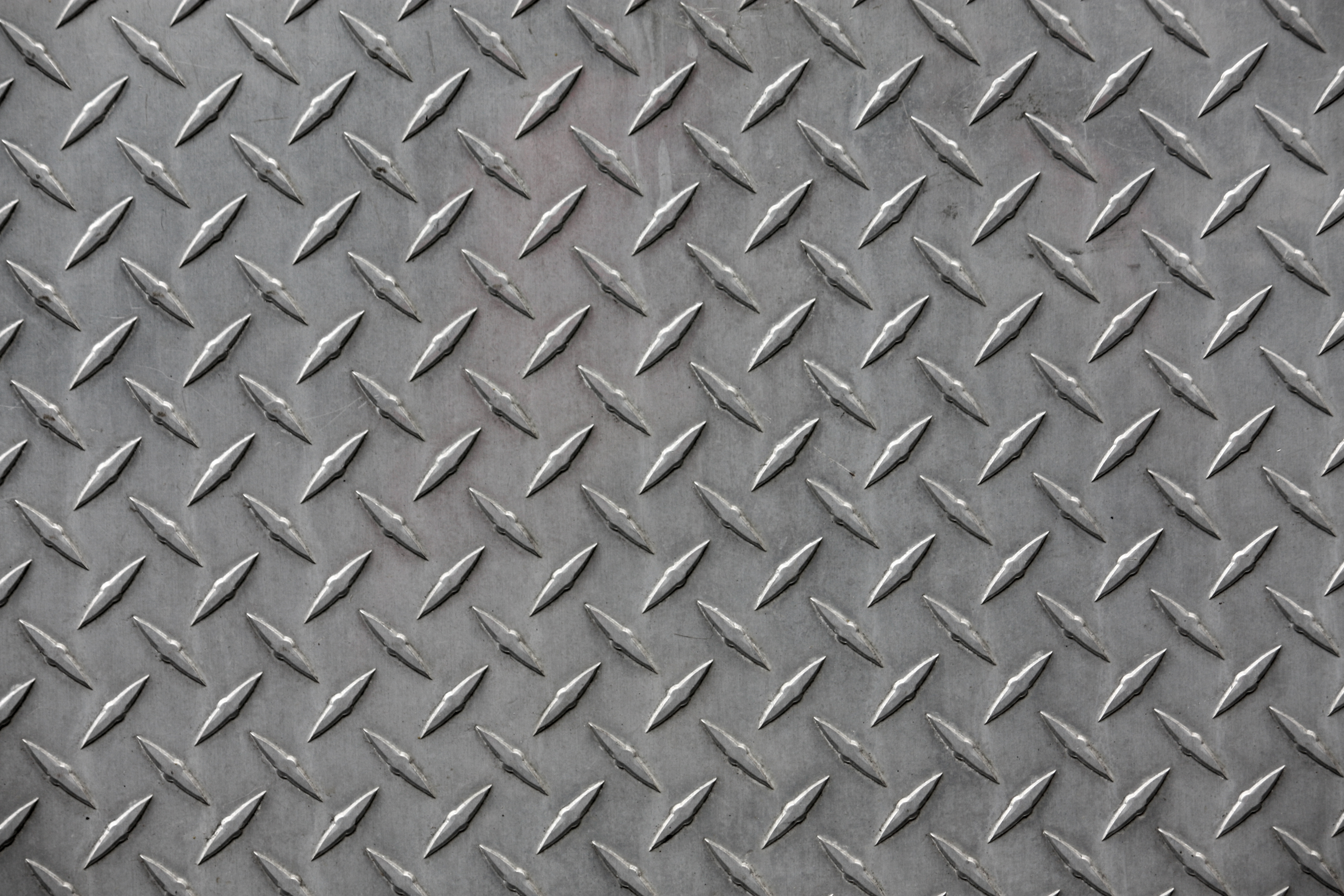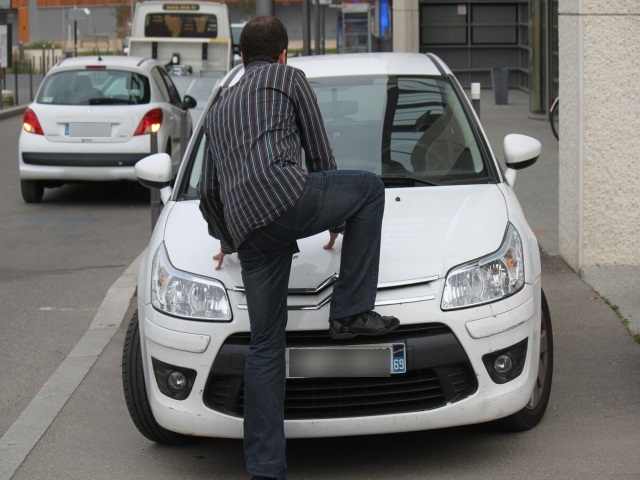|
Tread Plate
Tread plate, also known as checker plate and diamond plate, is a type of metal stock with a regular pattern or lines on one side for slip resistance. Diamond plate is usually steel, stainless steel or aluminium. Steel types are normally made by hot rolling, although modern manufacturers also make a raised and pressed diamond design. The most common alloy used for aluminium tread plate is 6061, although 5086-H34 and 3003-H231 are also used. The added texture reduces the risk of slipping, making diamond plate a solution for stairs, catwalks, walkways, and ramps in industrial settings. Its non-skid properties mean that diamond plate is frequently used on the interior of ambulances and on the footplates of firetrucks. Additional applications include truck beds and trailer floors. On bonnet to assist with access to roof rack, without damage from carwalking. Tread plate can also be used decoratively, particularly highly polished aluminium variants. Manufactured in plastic, diamond ... [...More Info...] [...Related Items...] OR: [Wikipedia] [Google] [Baidu] |
Fabrication (metal)
Metal fabrication is the creation of metal structures by cutting, bending and assembling processes. It is a value-added process involving the creation of machines, parts, and structures from various raw materials. Typically, a fabrication shop bids on a job, usually based on engineering drawings, and if awarded the contract, builds the product. Large fab shops employ a multitude of value-added processes, including welding, cutting, forming and machining. As with other manufacturing processes, both human labor and automation are commonly used. A fabricated product may be called a ''fabrication'', and shops specializing in this type of work are called ''fab shops''. The end products of other common types of metalworking, such as machining, metal stamping, forging, and casting, may be similar in shape and function, but those processes are not classified as fabrication. Processes *''Cutting'' is done by sawing, shear (sheet metal), shearing, or Chisel, chiselling (all with hand t ... [...More Info...] [...Related Items...] OR: [Wikipedia] [Google] [Baidu] |
Steel
Steel is an alloy of iron and carbon that demonstrates improved mechanical properties compared to the pure form of iron. Due to steel's high Young's modulus, elastic modulus, Yield (engineering), yield strength, Fracture, fracture strength and low raw material cost, steel is one of the most commonly manufactured materials in the world. Steel is used in structures (as concrete Rebar, reinforcing rods), in Bridge, bridges, infrastructure, Tool, tools, Ship, ships, Train, trains, Car, cars, Bicycle, bicycles, Machine, machines, Home appliance, electrical appliances, furniture, and Weapon, weapons. Iron is always the main element in steel, but other elements are used to produce various grades of steel demonstrating altered material, mechanical, and microstructural properties. Stainless steels, for example, typically contain 18% chromium and exhibit improved corrosion and Redox, oxidation resistance versus its carbon steel counterpart. Under atmospheric pressures, steels generally ... [...More Info...] [...Related Items...] OR: [Wikipedia] [Google] [Baidu] |
Stainless Steel
Stainless steel, also known as inox, corrosion-resistant steel (CRES), or rustless steel, is an iron-based alloy that contains chromium, making it resistant to rust and corrosion. Stainless steel's resistance to corrosion comes from its chromium content of 11% or more, which forms a Passivation (chemistry), passive film that protects the material and can self-healing material, self-heal when exposed to oxygen. It can be further alloyed with elements like molybdenum, carbon, nickel and nitrogen to enhance specific properties for various applications. The alloy's properties, such as luster and resistance to corrosion, are useful in many applications. Stainless steel can be rolled into Sheet metal, sheets, plates, bars, wire, and tubing. These can be used in cookware, cutlery, surgical instruments, major appliances, vehicles, construction material in large buildings, industrial equipment (e.g., in paper mills, chemical plants, water treatment), and storage tanks and tankers for ch ... [...More Info...] [...Related Items...] OR: [Wikipedia] [Google] [Baidu] |
Aluminium
Aluminium (or aluminum in North American English) is a chemical element; it has chemical symbol, symbol Al and atomic number 13. It has a density lower than that of other common metals, about one-third that of steel. Aluminium has a great affinity towards oxygen, passivation (chemistry), forming a protective layer of aluminium oxide, oxide on the surface when exposed to air. It visually resembles silver, both in its color and in its great ability to reflect light. It is soft, magnetism, nonmagnetic, and ductility, ductile. It has one stable isotope, 27Al, which is highly abundant, making aluminium the abundance of the chemical elements, 12th-most abundant element in the universe. The radioactive decay, radioactivity of aluminium-26, 26Al leads to it being used in radiometric dating. Chemically, aluminium is a post-transition metal in the boron group; as is common for the group, aluminium forms compounds primarily in the +3 oxidation state. The aluminium cation Al3+ ... [...More Info...] [...Related Items...] OR: [Wikipedia] [Google] [Baidu] |
Rolling (metalworking)
In metalworking, rolling is a metal forming process in which metal stock is passed through one or more pairs of rolls to reduce the thickness, to make the thickness uniform, and/or to impart a desired mechanical property. The concept is similar to the rolling of dough. Rolling is classified according to the temperature of the metal rolled. If the temperature of the metal is above its recrystallization temperature, then the process is known as hot rolling. If the temperature of the metal is below its recrystallization temperature, the process is known as cold rolling. In terms of usage, hot rolling processes more tonnage than any other manufacturing process, and cold rolling processes the most tonnage out of all cold working processes... Roll stands holding pairs of rolls are grouped together into rolling mills that can quickly process metal, typically steel, into products such as structural steel (I-beams, angle stock, channel stock), bar stock, and rails. Most steel mills ... [...More Info...] [...Related Items...] OR: [Wikipedia] [Google] [Baidu] |
6061 Aluminum Alloy
6061 aluminium alloy ( Unified Numbering System (UNS) designation A96061) is a precipitation-hardened aluminium alloy, containing magnesium and silicon as its major alloying elements. Originally called "Alloy 61S", it was developed in 1935. It has good mechanical properties, exhibits good weldability, and is very commonly extruded (second in popularity only to 6063). It is one of the most common alloys of aluminium for general-purpose use. It is commonly available in pre-tempered grades such as 6061-O (annealed), tempered grades such as 6061-T6 (solutionized and artificially aged) and 6061-T651 (solutionized, stress-relieved stretched and artificially aged). Chemical composition 6061 Aluminium alloy composition by mass: Properties The mechanical properties of 6061 greatly depend on the temper, or heat treatment, of the material. [...More Info...] [...Related Items...] OR: [Wikipedia] [Google] [Baidu] |
Stairway
A stairwell or stair room is a room in a building where a stair is located, and is used to connect walkways between floors so that one can move in height. Collectively, a set of stairs and a stairwell is referred to as a staircase or stairway. In buildings with several housing units, a stairway can be a necessary common area for getting to and from apartments. Staircases provide vertical access to connected floors in a multi-story building, and are a functional part of it. Stairwells are often used to place several staircases vertically, one above the other. The entrance to elevators is often located in the stairwell. Sometimes the stairwell goes around the lift shaft, other times it is placed next to it. A ''landing'' platform area is generally provided at both ends of a staircase, rather than having a long series of steps that directly leads to a doorway without a flat area between the steps and the door. Minimum requirements for landing platforms are typically established ... [...More Info...] [...Related Items...] OR: [Wikipedia] [Google] [Baidu] |
Footbridge
A footbridge (also a pedestrian bridge, pedestrian overpass, or pedestrian overcrossing) is a bridge designed solely for pedestrians.''Oxford English Dictionary'' While the primary meaning for a bridge is a structure which links "two points at a height above the ground", a footbridge can also be a lower structure, such as a boardwalk, that enables pedestrians to cross wet, fragile, or marshy land. Bridges range from stepping stones–possibly the earliest man-made structure to "bridge" water–to elaborate steel structures. Another early bridge would have been simply a fallen tree. In some cases a footbridge can be both functional and artistic. For rural communities in the developing world, a footbridge may be a community's only access to medical clinics, schools, businesses and markets. Simple suspension bridge designs have been developed to be Sustainability, sustainable and easily constructed in such areas using only local materials and labor. An enclosed footbridge between t ... [...More Info...] [...Related Items...] OR: [Wikipedia] [Google] [Baidu] |
Hood (car)
The hood (American English) or bonnet (Commonwealth English) is the hinged cover over the engine of motor vehicles. Hoods can open to allow access to the engine compartment, or trunk (boot in Commonwealth English) on rear-engine and some mid-engine vehicles) for maintenance and repair. Terminology In British terminology, ''hood'' refers to a fabric cover over the passenger compartment of the car (known as the 'roof' or 'top' in the US). In many motor vehicles built in the 1930s and 1940s, the resemblance to an actual hood or bonnet is clear when open and viewed head-on. In modern vehicles it continues to serve the same purpose but no longer resembles a head covering. Styles and materials On front-engined cars, the hood may be hinged at either the front or the rear edge, or in earlier models (e.g. the Ford Model T) it may be split into two sections, one each side, each hinged along the centre line. Another variant combines the bonnet and wheelarches into one section whic ... [...More Info...] [...Related Items...] OR: [Wikipedia] [Google] [Baidu] |
Carwalking
Carwalking is the act of stepping onto and walking across a stationary car. Depending on the technique and equipment used, carwalking can lead to Property damage, damage of private property. It often is a response to cars being parking violation, parked illegally in areas exclusively allocated to pedestrians and a protest against the negative impacts of high List of countries by vehicles per capita, motorization rates in urban areas. Reported cases Germany The most famous carwalker was Michael Hartmann who performed the act in Munich, Germany, in the 1980s. The peak of automobile friendly policies was around the seventies and the eighties in the western world, and such high number of motor vehicles in urban areas had as consequence a large number of cars illegally parked on side-walks and other pedestrian-reserved areas. Hartmann, in his book which describes his actions, states that once in 1988 he was walking with his girlfriend and due to many cars parked on the sidewalk, they ... [...More Info...] [...Related Items...] OR: [Wikipedia] [Google] [Baidu] |
Structural Steel
Structural steel is steel used for making construction materials in a variety of shapes. Many structural steel shapes take the form of an elongated beam having a profile of a specific cross section (geometry), cross section. Structural steel shapes, sizes, chemical composition, mechanical properties such as strengths, storage practices, etc., are regulated by Technical standard, standards in most industrialized countries. Structural steel shapes, such as I-beams, have high Second moment of area, second moments of area, so can support a high Structural load, load without excessive Hogging and sagging, sagging. Structural shapes The shapes available are described in published standards worldwide, and specialist, proprietary cross sections are also available. *I-beam, I-beam (serif capital 'I'-shaped cross-section – in Britain these include Universal Beams (UB) and Universal Columns (UC); in Europe it includes the IPE, HE, HL, HD and other sections; in the US it includes Wide ... [...More Info...] [...Related Items...] OR: [Wikipedia] [Google] [Baidu] |






